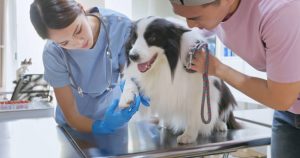CL (neuronal ceroid lipofuscinosis or NCL) is a cluster of hereditary neurological degenerations in people or animals. In Border Collies, CL results from the mutation in the CLN5 gene, causing an abnormal build-up of trash material in the brain and neural system tissues. It is a slowly killing disease, where the dogs often die before becoming two years old.
What is Neuronal Ceroid Lipofuscinosis?
Lysosomal storage diseases like neuronal ceroid lipofuscinosis (NCL), characterized by the nervous system’s degeneration are a genetic disorder that occurs due to mutations in different genes. That also causes the accumulation of lipopigment metabolites in the neuronal cells of the brain and other tissues.
This is why a mutation in the CLN5 gene in Border Collies triggers the disease. The gene specifies the protein necessary in a lysosome function whose job is to break down waste products and recycle cells. Lysosomal storage disease occurs when this gene is mutated, and lysosomes do not function correctly. Consequently, lipopigment accumulates in the neuron.
In most cases, Border Collie sufferers start experiencing NCL symptoms aged between one and four years. Therefore, Border Collie owners should keep an eye on the symptoms of the disease, working together with their vet.
Inheritance of Neuronal Ceroid Lipofuscinosis in Border Collies
NCL is a genetically inheritable disease that attacks the dog’s central nervous system. The condition develops due to the accumulation of toxic debris in the brain and other organs. NLC affects the Border Collies autosomal recessively, so a dog has to have two mutated genes, in this case, from the parents, to contract the disease.
Clear
Clear dogs free of the NCL mutation possess two ordinary copies of the gene and do not suffer from the disease. They can only transmit healthy versions of the gene to their offspring.
Carrier
In dogs, for example, the carrier of the NCL mutation has a typical copy and an abnormal gene. They will not be affected by the condition. However, they may transmit a “normal” version or a “mutant” one to them.
Affected
A double copy of the mutant gene in dogs afflicted with NCL makes them susceptible to the problem. Symptoms typically develop at around a year old, sometimes up to four years of age, manifesting as sight loss, seizures, or cognitive impairment. Sadly, there is no treatment for the condition, and afflicted dogs tend to die early.
History of Ceroid Lipofuscinosis in Border Collies
CL, more commonly called Ceroid Lipofuscinosis, is a family of inherited neurodegenerative diseases in humans and animals, particularly among dog breeds. Mutation in the CLN5 gene triggers the deposition of lipopigments within the brain and other tissues in the case of Border Collies.
A litter of Border Collie puppies were found to have neurology defects in England in 1995. Since then, CL has been recognized as being present in Border Collies in many countries such as the UK, USA, Canada, Australia, and New Zealand.
The occurrence of CL among Border Collies differs within populations and in specific localities. The prevalence can range from as high as 10% in certain regions to deficient numbers in others.
What Breeds of Dogs are likely to Develop NCL?
NCL, or neuronal ceroid lipofuscinosis, is a hereditary disease affecting most of these dogs’ breeds, including border collies. Nonetheless, certain species may predispose towards NCL.
The following is a list of dog breeds that are known to be at risk of developing NCL:
- Border Collie
- Australian Cattle Dog
- Finnish Lapphund
- English Setter
- American Bulldog
- Dachshund
- English Pointer
- Chihuahua
- Boston Terrier
However, it should be noted that this list is not extensive at all, and some other breeds are at risk of acquiring NCL. For this disease, a genetic defect occurs specifically for a specific gene, leading to inheritance following an autosomal recessive pattern. For a dog to get this disease, it must inherit two copies of the mutant gene in question – one from the mother and another from the father.
Signs and Symptoms of NCL
Border Collies are affected by a progressive neurodegenerative disorder known as neuronal ceroid lipofuscinosis. It results from the deposition of lipopigments in the cerebrum and nervous tissue, which causes cellular destruction. Signs and symptoms of NCL may differ depending on the stage of the disease.
The beginning stage of NCL can manifest with subtle indicators, including altered behavior, an increase in anxiousness, agitation, and, at times, even aggressive behaviors in affected dogs. They might also collide with objects like walls, experience difficulty maneuvering around familiar environments, etc. This may make some dogs fearful of the darkness and cause others to have trouble seeing in conditions with low light.
With time, other symptoms may appear, like blindness, epilepsy, or weakened muscles in the affected dog. However, they often do not digest food completely and might experience difficulty swallowing or vomiting. Urinary and fecal incontinence can also occur among some dogs, making them behave differently when they go to a new place.
Affected dogs lose vision, walking, and sitting abilities in the late stage of NCL. This can also lead to shortness of breath, which eventually culminates into cases of pneumonia. Some of those dogs will suffer intractable seizures, which cannot be managed using medications.
One must note that the manifestations of NCL are comparable with many other neurological diseases; therefore, only a molecular examination can identify it. Detecting and treating the disease early may not completely stop it, but it will slow its progression and enhance the quality of their lives.
What Causes NCL in Dogs?
Neuronal Ceroid Lipofuscinosis (NCL) is a genetic disease in a dog’s nervous system. Mutations of the CLN5 gene result in the production of abnormal waste-removing proteins, leading to the onset of the disorder. As a result of such mutation, lipofuscin builds up inside the cells of the brain and other tissues. Lipofuscin accumulates and kills off the nerve cells over time, resulting in the clinical manifestation of NCL.
Namely, NCL is an autosomal recessive condition in which a dog needs to possess two NCL alleles inherited, one from each parent. Affected dogs acquire two copies of this mutation, while carrier hounds acquire just one copy of the mutated gene.
How is Neuronal Ceroid Lipofuscinosis diagnosed?

The diagnosis of NCL in Border Collies requires the presence of clinical signs, laboratory tests, and imaging. NCL’s manifestations are usually similar to other illnesses, which complicates diagnosis by the clinical signs. A diagnostic procedure usually includes a comprehensive physical exam, neurologic assessment, and detailed medical history. Other medical tests, such as blood testing, are typically administered to rule out other medical conditions, which often have the exact nature of symptoms and may present similar signs.
Through a genetic test, NCL can be accurately diagnosed. The Border Collie’s DNA is extracted, and a mutation search is conducted on the genes implicated in NCL (CLN5 and CLN6). Besides genetic testing, other diagnostic techniques like MRI are used to check for cases of NCL. MRI can reveal specific morphological changes in the brain indicative of this illness, like brain shrinkage and lipofuscin deposition.
Is NCL curable?
There is no treatment for NCL, but several options are available to control its symptoms. Such treatments may involve prescribing anti-seizure medications or therapies aimed at symptomatic relief, improving their quality of life. These practices include screening, DNA testing, and careful breeding practices to lower the probability of NCL in Border Collies. Moreover, cautious breeding can also preempt the condition.
How can CL in Border Collies be Prevented?
CL prevention in Border Collies incorporates both genetic tests and responsible breeding strategies. In this case, genetic testing can reveal the carrier’s and affected dog’s status so breeders may base their pairings on sound knowledge. Only the pure and free ones (clear dogs) must be used to breed to avoid the transmission of the CL gene to the following generation.
The other approach to preventing this disease is through responsible breeding that includes no incestuous mating and selecting healthy parents with good behaviors among the Border Collies. The owners of Border Collies also need to recognize the signs and symptoms of CL and immediately take their infected canine to the vet for treatment. Early treatment slows down the disease process in these dogs and improves their quality of life.
Testing Your Border Collie
It is advisable to have a test done to determine whether or not your Border Collie has NCL (Neuronal Ceroid lipofuscinosis) because if this condition is not detected timely, it could lead to death. Such tests may prove whether your dog is a carrier, an affected dog, or a dog that is clear of the disease.
Sample Requirement
A tiny drop of blood is needed from your Border Collie to carry out the test. Your vet should take a sample and send it to the lab. Proper collection and storage of the sample are essential to preserve the integrity of the DNA.
Turnaround Time
Laboratory-dependent response times may be experienced during CLI testing. Typically, one should expect a result during these two to four weeks. Specific labs may carry out a fast-track option at an extra charge.
Price
Again, the price of CL testing for the Border Collie may depend on the laboratory you use. This expense usually averages between a hundred and two hundred dollars. Before sending a sample to the laboratory, one should determine the exact cost and whether any extra charges will be levied.
NCL in Border Collies in a Nutshell
Dogs suffer from Neuronal Ceroid Lipofuscinosis (NCL), which affects the nervous system. The condition results from a defect associated with the CLN5 gene, whereby lipopigments deposit on the brain and other organs. One of the predisposing breeds is the Border Collie.
In Border Collies, the initial symptoms of NCL are evident from 18 months to two years old. Symptoms that can manifest in dogs with NCL may vary. Affected dogs can become blind, will not be able to walk, and would find it difficult to eat or drink as the disease runs its course. Sadly, there is no remedy for NCL among Border Collies.
Before investing in a Border Collie, you should know about NCL and collaborate with an honest breeder undertaking CLN5 gene screening. This way, you will contribute to lowering cases of NCL in your favorite breed and ensure that your new furry friend has the best chance for a good and long life.



